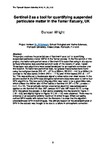Sentinel-2 as a tool for quantifying suspended particulate matter in the Tamar Estuary, UK
| dc.contributor.author | Wright, D. | |
| dc.date.accessioned | 2019-05-22T08:49:35Z | |
| dc.date.available | 2019-05-22T08:49:35Z | |
| dc.date.issued | 2018 | |
| dc.identifier.citation |
Wright, D. (2018) 'Sentinel-2 as a tool for quantifying suspended particulate matter in the Tamar Estuary, UK', The Plymouth Student Scientist, 11(2), p. 3-33. | en_US |
| dc.identifier.issn | 1754-2383 | |
| dc.identifier.uri | http://hdl.handle.net/10026.1/14182 | |
| dc.description.abstract |
This project explores the potential use of Sentinel-2 as a tool for quantifying suspended particulate matter (SPM) in the Tamar estuary. In the first section of this project, the radiometric performance of Sentinel-2B is quantified using in situ above-surface reflectance data acquired autonomously off the waters of Lanai, Hawaii. Three band ratio algorithms were tested/developed for atmospheric correction over this location. No band ratio performed best, but greater inaccuracies were found using the red/green bands (RD -27 – -87 % at 560nm, RD 312 – 440 % at 665nm) in contrast to the blue bands (443nm (RD 4 – 11 %) and 491nm bands (RD -8 – -17 %). This was attributed to inadequate signal to noise ratios over clear waters. In the second section in situ SPM data alongside radiometric data were used to derive four SPM algorithms. The best performing algorithm was found to be a green/blue ratio, which utilised the 560nm and 497nm bands of Sentinel-2A (R2 = 0.761, p-value < 0.01, N = 15). The empirically derived exponential algorithm was subsequently applied to two Sentinel-2A tiles (25th January 2017 and 26th March 2017) to map SPM throughout the estuary. A river plume extending into the Sound in Figure 11 (LW + 0.5) and slightly higher in Figure 12 (LW + 1.5) were observed. There was no evidence of an estuarine turbidity maximum in either image. When comparing derived SPM results with values from the literature it is clear that the algorithm underestimated SPM in both images. The primary reason for the underestimation of SPM in the estuary was thought to be due to a failure in atmospheric correction. | en_US |
| dc.language.iso | en | en_US |
| dc.publisher | University of Plymouth | |
| dc.rights | Attribution 3.0 United States | * |
| dc.rights.uri | http://creativecommons.org/licenses/by/3.0/us/ | * |
| dc.subject | Sentinel-2 | en_US |
| dc.subject | suspended particulate matter | en_US |
| dc.subject | Tamar Estuary | en_US |
| dc.subject | Sentinel-2B | en_US |
| dc.subject | radiometric performance | en_US |
| dc.subject | Lanai, Hawaii | en_US |
| dc.subject | radiometric data | en_US |
| dc.subject | estuarine turbidity | en_US |
| dc.title | Sentinel-2 as a tool for quantifying suspended particulate matter in the Tamar Estuary, UK | en_US |
| dc.type | Article | |
| plymouth.issue | 2 | |
| plymouth.volume | 11 | |
| plymouth.journal | The Plymouth Student Scientist |



